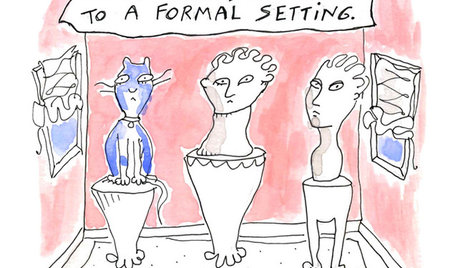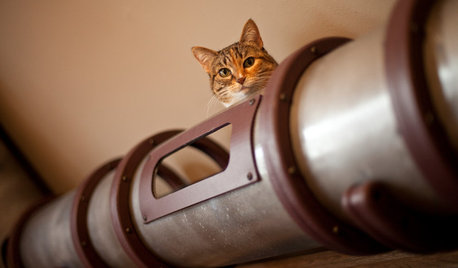Question Re Giving Feline IV's
dwmc
10 years ago
Related Stories

PETSSee a Deluxe 'Catio' Built for Feline Fun
Sixteen lucky cats get the run of a protected outdoor patio with ramps, steps and even a koi pond
Full Story
PETSIncredible Home Catwalks Make for Purr-fectly Happy Felines
Walkways and tunnels custom built to the tune of about $35,000 keep a homeowner’s 18 cats on cloud nine
Full Story
MOST POPULAR7 Ways Cats Help You Decorate
Furry felines add to our decor in so many ways. These just scratch the surface
Full Story
PETSSo You Want to Get a Cat
If you're a cat lover, the joys outweigh any other issue. If you haven't lived with one yet, here are a few things to know
Full Story
FUN HOUZZGeek Lab: How to Build a Steampunk Cat Transit System
Give your kitty another avenue for fun with a tubular walkway system that lets him go his own way
Full Story
COMMUNITYSimple Acts: The Unsung Power of a Good Neighbor
There are many ways to be a good neighbor, and they're often easier than you think
Full Story
HOME TECHFacebook Meets Fido: Pet Connections for the Digital Age
Three new products let you communicate with your dog or cat while you're at work
Full Story
DECORATING GUIDES23 Ways to Put Your Home in Hipster City
Be one of the cool kids no matter what your age, with these tips for giving your home a creative, colorful or edgy vibe
Full Story
FRONT YARD IDEASWelcome Edibles Into the Front Yard for Fresh Food and More
Give your front yard design a boost and maybe even make new friends by growing fruits and vegetables
Full Story
ORGANIZING‘Tidying Up’ Author Marie Kondo Tells How to ‘Spark Joy’ at Home
A new book from the author of ‘The Life-Changing Magic of Tidying Up’ delves deeper into her KonMari Method of decluttering and organizing
Full StoryMore Discussions








mudhoney
socks
Related Professionals
South Pasadena Architects & Building Designers · West Palm Beach Architects & Building Designers · Glendale Heights Cabinets & Cabinetry · Land O Lakes Cabinets & Cabinetry · Sunset Cabinets & Cabinetry · Watauga Cabinets & Cabinetry · Dracut Flooring Contractors · Federal Way Flooring Contractors · Lake Stevens Flooring Contractors · Lynbrook Flooring Contractors · Oswego Flooring Contractors · Seymour Flooring Contractors · Stoneham Flooring Contractors · Summerville Flooring Contractors · Wyoming Flooring ContractorsdwmcOriginal Author
laurief_gw
spedigrees z4VT
lisa_fla
dwmcOriginal Author
laurief_gw
User
laurief_gw
dwmcOriginal Author
spedigrees z4VT
laurief_gw
dwmcOriginal Author
laurief_gw
spedigrees z4VT
petaloid